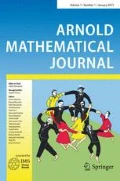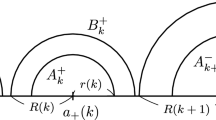Abstract
A portrait is a combinatorial model for a discrete dynamical system on a finite set. We study the geometry of portrait moduli spaces, whose points correspond to equivalence classes of point configurations on the affine line for which there exist polynomials realizing the dynamics of a given portrait. We present results and pose questions inspired by a large-scale computational survey of intersections of portrait moduli spaces for polynomials in low degree.









Similar content being viewed by others
Notes
In fact, if \(B_{d,e}\) exists, it is not too difficult to show that the inequality \(B_{d,e} \ge d\) must necessarily hold. For the purposes of this discussion, though, we do not need to prove this.
Let \({\mathcal {P}}'\) be the weighted portrait, in the terminology of [5], obtained by adding to \({\mathcal {P}}\) a single fixed point of weight d, corresponding to a totally ramified fixed point. The cited results of [5] show that the parameter space associated to \({\mathcal {P}}'\)—denoted \(\mathrm{End}_d^1[{\mathcal {P}}']\) in [5]—has dimension \(d + 2\), but we lose a dimension by moving the totally ramified fixed point to \(\infty \).
From the perspective of \(\mathrm {PGL}_2\) acting on \(\widehat{{\mathbb {C}}}\) by Möbius transformations, the group \(\mathrm {Aff}_1\) is the Borel subgroup of upper triangular matrices in \(\mathrm {PGL}_2\).
If \({\mathcal {P}}\) is the identity portrait on n elements, then \(\dim _{{\mathcal {P}},1} = n\) by Proposition 2.5. Moreover, by Proposition 2.8, \({\mathcal {P}}\) is admissible in degree d if and only if \(n \le d\). In this case, \(\dim \mathrm {Conf}_{{\mathcal {P}},d} = d + 1 > n = \mathrm {Conf}_{{\mathcal {P}},1}\), so the subsequent discussion is still valid for the identity portrait \({\mathcal {P}}\).
Details of the calculations described here may be found in the Sage notebook https://github.com/tghyde/portrait_moduli_supplement.
References
Beardon, A. F.: Iteration of rational functions, Graduate Texts in Mathematics, vol 132. Springer (1991)
Cargo, G.T., Schneider, W.J.: Polynomial images of circles and lines. Math. Mag. 40, 1–4 (1967). https://doi.org/10.2307/2689173
Chen, J.-F.: Uniqueness of meromorphic functions sharing two finite sets. Open Math. 15, 1244–1250 (2017)
De Marco, L., Krieger, H., Ye, H.: Common preperiodic points for quadratic polynomials (2019). preprint. arXiv:1911.02458
Doyle, J.R., Silverman, J.H.: Moduli spaces for dynamical systems with portraits. Illinois J. Math. 64(3), 375–465 (2020). https://doi.org/10.1215/00192082-8642523
Morton, P., Silverman, J.H.: Rational periodic points of rational functions. Internat. Math. Res. Not. 1994(2), 97–110 (1994). https://doi.org/10.1155/S1073792894000127
Silverman, J. H.: The arithmetic of dynamical systems, Graduate Texts in Mathematics, vol241. Springer (2007)
Acknowledgements
This material is based upon work supported by NSF Grant DMS-1439786 while the authors were in residence at the Institute for Computational and Experimental Research in Mathematics (ICERM) in Providence, RI, during the Summer@ICERM 2019 program on Computational Arithmetic Dynamics. We thank ICERM and Brown University for their hospitality during the eight-week program. We would like to thank Ben Hutz, Bianca Thompson, and Adam Towsley who, along with the second author, organized the Summer@ICERM program. We thank Grayson Jorgenson for helpful discussions while this article was being prepared, and we thank Paul Fili for lending us computing resources. We thank the anonymous referee for extensive feedback and suggestions. John Doyle was partially supported by NSF Grant DMS-2112697, Trevor Hyde was partially supported by the NSF Postdoctoral Research Fellowship DMS-2002176 and the Jump Trading Mathlab Research Fund, Colby Kelln was supported by an NSF Graduate Research Fellowship under Grant DGE-1650441, and Max Weinreich was supported by an NSF Graduate Research Fellowship under Grant DGE-2040433.
Author information
Authors and Affiliations
Corresponding author
Additional information
Publisher's Note
Springer Nature remains neutral with regard to jurisdictional claims in published maps and institutional affiliations.
Rights and permissions
About this article
Cite this article
Blum, T., Doyle, J.R., Hyde, T. et al. Dynamical Moduli Spaces and Polynomial Endomorphisms of Configurations. Arnold Math J. 8, 285–317 (2022). https://doi.org/10.1007/s40598-022-00197-z
Received:
Revised:
Accepted:
Published:
Issue Date:
DOI: https://doi.org/10.1007/s40598-022-00197-z




